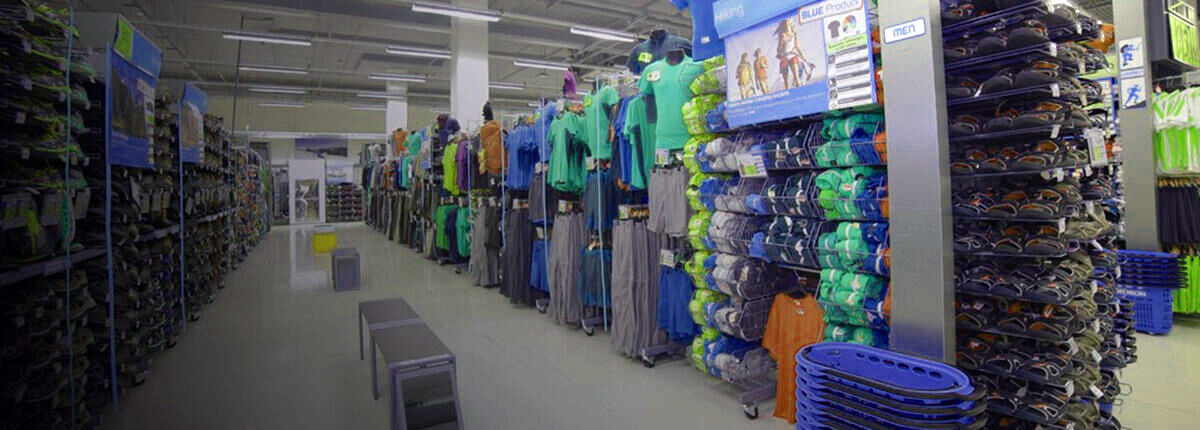RFID Case Study: Decathlon uses Tageos RFID labels to identify millions of items worldwide
Tageos
Contact usDecathlon is one of the world’s major retailers of sporting goods and equipment. The French company sells more than 600 million individual products every year through a network of more than 900 stores in Europe, Africa, South America and Asia.
Challenge
When considering to deploy RFID tagging, Decathlon’s main goal was to increase product availability in the stores. They wanted to ensure that sales were not being lost because shoppers were not able to find desired products. The challenge was to deploy the RFID tagging solution for their brands. Decathlon is very innovative and likes using new technologies to improve their customers’ shopping experience. Using RFID innovation would also facilitate an accelerated checkout experience, which together with improved product availability convinced them to make the strategic decision to deploy an RFID solution.
Solution
Decathlon’ RFID solution is integrated in all steps of their supply chain. The factories, more than 40 distribution centers, and more than 900 stores are equipped with and reap the benefits of RFID. Decathlon started the source-tagging of all its own branded products at the manufacturing plants in 2013. RFID labels were placed on items during the manufacturing process, encoded with a unique identification number stored in the retailer’s database.
Decathlon tracks products throughout the entire supply chain, from factories to the distribution centers and stores all over the world. In the manufacturing factories, Decathlon suppliers use handheld RFID readers to record and track the shipping of goods to the distribution centers. The RFID identification makes the tracking process easier and faster, and reduces the risk of error.
When a product arrives at a distribution center, using fixed RFID readers (the Impinj R420) the product ID is read from the RFID tag and recorded. The products are then stored for the picking process. Non-Decathlon items which are not yet source-tagged at the factory are tagged with an RFID label at the distribution center. In total, more than 85% of products are RFID tagged.
Decathlon uses the Tageos 100% paper-based EOS-300 Monza R6-P RFID label to tag non-Decathlon products at the distribution centers. The label (54×34 mm/2.13×1.34 in) has been specifically designed for Decathlon in order to match the various types and sizes of product items to be tagged. It comes in a specific format as a double sticker: on the backing sheet, alongside of the standard EOS-300 label, a smaller non-RFID blank sticker is used to print some visual data to help logistics staff during the labeling process.
In order to take an even greater advantage of this benefit, Decathlon and Tageos have worked intensively on the label packaging itself. The retailer opted for a fanfold stack form which allows doubling the number of RFID labels (8000 RFID labels per stack) compared to using roll form. Tageos developed a dedicated packaging for those fanfold stacks. A large custom box contains two smallers boxes of 8000 RFID labels carefully packaged in order to facilitate the printing process in the distribution centers. Decathlon operators simply grab a large box of 16000 labels and place it behind their Toshiba printers, remove the boxes lids and load the labels. They launch printing jobs of 16000 labels (instead of less than 4000 labels if using rolls) and there by reduce the frequency of reloading the rolls in the printers.
The labels are printed and encoded with a unique identification number. Once the source-tagged goods are received and the other branded goods have been RFID tagged, different types of RFID systems such as mobile readers or RFID reading tunnels are used to perform cycle counts and shipping control. Decathlon can ensure that the right products are shipped to the right stores.
After products arrive at the stores, they are placed on display shelves ready and available for shoppers. Store staff use an ergonomic and light RFID handheld reader connected by Bluetooth to a smartphone, to perform shelf inventories, 5 times faster than with the former systems and technologies.
Decathlon also installed RFID based check-out systems in order to facilitate and accelerate the payment process. The system consists of an RFID reader embedded into the check-out table. When a customer wishes to check-out, the cashier simply passes the products across the top of the table to read the product RFID ID encoded into the label without having to use a traditional barcode system.
The retailer installed EAS-RFID gates at the stores entrance. RFID tags are detected when passing through the gates so the system can check if the products have been purchased or not, and thus start an alarm to alert the security staff.
Result
Only five years after the first RFID tests took place in 2010, the RFID solution deployed by Decathlon showed gains within the whole supply chain. Among the multiple benefits of the solution, the improvements on inventory tracking and shelf availability are significant. Thanks to the RFID tagging of every product, a full store inventory can be performed as often as every 1-4 weeks depending on the store, instead of twice per year using barcodes. The overall product visibility is improved and labor costs have been reduced.
The result is much improved product availability and a reduction of lost sales. In manufacturing factories, from the tagging to the shipment, in distribution centers receiving, inventory fulfilment and order preparation, and in stores for shelves inventory and payment, the RFID deployment at Decathlon had a positive and measurable improvement on key logistics and store processes, reducing related operational costs while providing a complete visibility of items and improving customers experience and satisfaction.
Do you also want to identify your items with RFID or increase product availability? One of our experts will be more than happy to help you. Please contact us.
About
Tageos designs, manufactures and sells globally patented 100% paper-based passive UHF RFID labels. The product range is extensive, allowing customers to conveniently label all items of various shapes and sizes.
